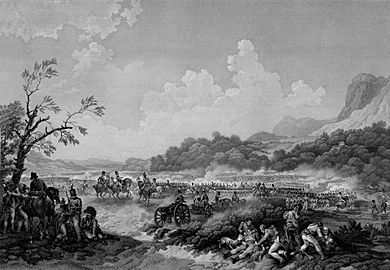Philip James de Loutherbourg facts for kids
Quick facts for kids
Philip James de Loutherbourg
|
|
|---|---|
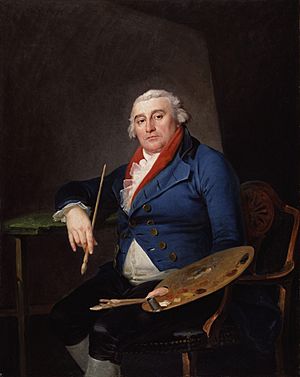
Philip James de Loutherbourg, self-portrait
|
|
| Born |
Philippe Jacques de Loutherbourg
31 October 1740 |
| Died | 11 March 1812 (aged 71) |
| Nationality | British |
| Education | Charles-André van Loo Francesco Giuseppe Casanova |
| Known for | Painting |
|
Notable work
|
Lord Howe's action, or the Glorious First of June Coalbrookdale by Night |
| Movement | History painting Military art |
Philip James de Loutherbourg RA (born October 31, 1740 – died March 11, 1812) was a famous painter. He was born in France but later became a British artist. He was known for his large paintings of naval battles and his amazing designs for theatre stages in London.
Philip also invented a special mechanical theatre called the "Eidophusikon." He was interested in unusual ideas, including a belief in healing people without medicine.
Contents
Early Life and Art Training
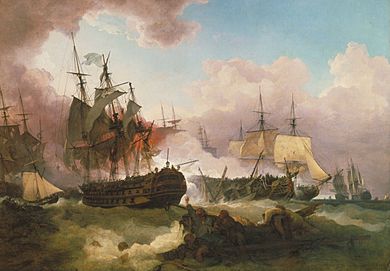

Philip de Loutherbourg was born in Strasbourg, France, in 1740. His father was a Polish miniature painter. Philip was supposed to become a minister in the church. He even studied at the University of Strasbourg.
Becoming a Painter in Paris
But Philip decided to become an artist instead. In 1755, he began studying painting in Paris. His teachers were Charles-André van Loo and Francesco Giuseppe Casanova. Philip quickly became very good at painting.
By 1767, he was chosen to join the French Academy. This was a big honor for artists. He painted many different types of scenes. These included landscapes, stormy seas, and battle scenes. His work became very popular in Paris. Some of his first famous paintings were Storm at Sunset and Morning after Rain.
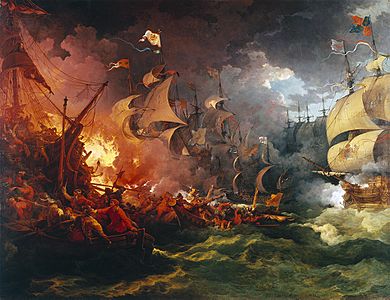

Travels and New Ideas
After his time in Paris, Loutherbourg traveled a lot. He visited Switzerland, Germany, and Italy. During his travels, he showed off his paintings and also his clever mechanical inventions. One of his inventions was a model theatre. It used special lights to make the moon and stars appear. It also made water look like it was really flowing. This amazed everyone who saw it.
Moving to London
Theatre Work
In 1771, Philip de Loutherbourg moved to London. There, the famous theatre manager David Garrick hired him. Philip was paid a lot of money to design the sets and costumes for the Theatre Royal, Drury Lane. He also helped with the stage machinery.
His stage effects were so good that they impressed everyone. Even other artists, like Joshua Reynolds, admired his work. Philip created amazing illusions. For example, he could make green trees slowly turn russet (a reddish-brown color). He also made the moon rise and light up the edges of clouds. He did this using colored lantern-slides and clever lighting. He worked at the theatre until 1785.
The Eidophusikon
Philip had an even bigger success with a special show called the Eidophusikon. This name means "image of nature." It was a small mechanical theatre, only about six by eight feet. It showed "Moving Pictures" that looked like natural events.
He presented this show in his home starting in 1781. About 130 people could watch at a time. He used special lamps and colored glass to change the lighting and colors on stage.
Later, Philip tried to create even more fantastic scenes for the Eidophusikon. One scene showed "Satan arraying his troops on the banks of the Fiery Lake." However, the Eidophusikon soon closed. It cost too much to run, and people wanted new shows faster than Philip could create them.
Some people thought he invented the panorama. But the first panorama was actually painted by a Scottish artist named Robert Barker.
Painting in London
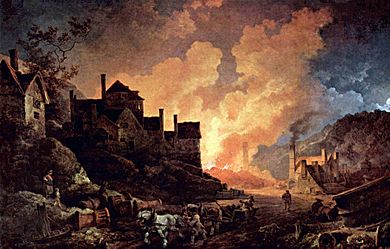
Even with all his theatre work, Philip still found time to paint. He created large naval paintings to celebrate British navy victories. One famous painting is Lord Howe's action, or the Glorious First of June (1795). Many of these paintings are now in the National Maritime Museum. His painting Destruction of the Armada is considered one of his best.
He also painted historical events, like the Great Fire of London. Philip was interested in the Industrial Revolution. His 1801 painting Coalbrookdale by Night shows iron factories working at night.
Seven of his paintings are in the Government Art Collection. These include Lodore Waterfall and Skating in Hyde Park. In 1781, he became a member of the Royal Academy.
Later Interests
In 1789, Loutherbourg stopped painting for a short time. He became interested in unusual ideas, including a belief in healing without medicine. He and his wife tried to heal people. A pamphlet was published in 1789 that claimed they had helped many people.
Death and Legacy
Philip de Loutherbourg passed away in Chiswick, west London, in 1812.
His paintings can be found in many British museums. These include Tate Britain, the Victoria and Albert Museum, and the National Portrait Gallery.
Loutherbourg was buried in Chiswick Old Cemetery. Other famous artists, like William Hogarth, are also buried nearby.


